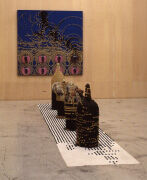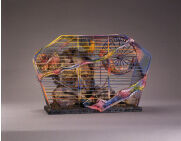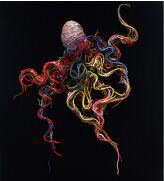KUDO Tetsumi(1935-1990)
KUDO Tetsumi was born in 1935 in Osaka as the firstborn son of KUDO Masayoshi, a painter originally from Goshogawara City. Masayoshi had graduated from the Tokyo School of Fine Arts and taught art at Sakai Junior High School in Osaka, while Tetsumi’s mother, Yoshiko, also taught art at Kakogawa Girls’ School in Hyogo Prefecture. As the conflict of World War II intensified, the family returned to Aomori, where Masayoshi taught at Aomori Normal School. In this environment, Tetsumi began to make art at an early age. Upon Masayoshi’s death after the end of the war in 1945, the family relocated from Goshogawara City to Hirosaki City. In Tetsumi’s third year of junior high school, the family moved back to Yoshiko’s hometown of Okayama City, and Tetsumi entered the newly established Tokyo University of the Arts. Although he enrolled in the painter Takeshi Hayashi’s class as his course of study, the rebellious Tetsumi did not attend lessons and instead explored his own artistic direction, strongly influenced by images such as color pictures of mineral crystals and electron micrographs of cells in scientific journals and physics manuals.
Eventually, Tetsumi’s early two-dimensional works composed of sets of points gave way to three-dimensional works such as scrub brushes entangled in tied-together white and yellow plastic string. “Proliferating Chain Reaction (B),” a work he presented at the twelfth annual Yomiuri Indépendant Exhibition in 1960, was described by the art critic TONO Yoshiaki as “junk anti-art.” The culmination of this concept can be found in Tetsumi’s 1960-61 series “Philosophy of Impotence.”
After winning a ticket to Europe in the Second International Young Artists’ Exhibition in 1962, Tetsumi traveled to Paris with his wife, where he produced shocking, obscene works that attacked Europe’s impotent humanism. In 1969, he briefly returned to Japan and carried out a project to carve a massive relief sculpture, titled “Monument of Metamorphosis (Chrysalis),” into a rock face of Mount Nokogiri in Minami-Boso Quasi-National Park, Chiba Prefecture. Afterwards, he returned to Paris and adopted environmental pollution as a new theme, beginning a series of works titled “Pollution – Cultivation – New Ecology” around 1970.
In the late 1970s, he switched to creating introspective, meditative works such as “Portrait of the Artist in Crisis.” He won a special honorary award at the 1977 São Paulo Art Biennial, and in that the same year, Pollution-cultivation-nouvelle écologie was featured in an exhibition to commemorate the opening of the Pompidou Centre in Paris. Thus, his international reputation also gradually grew.
Tetsumi was hospitalized to treat his alcoholism in 1980 and returned to Japan in 1983. With a studio in Hirosaki City, he began to divide his time between Paris and Tsugaru. Around this period, he produced works with the motifs of Tsugaru kites and the jomon cord marks found on prehistoric Japanese pottery, as exemplified by Suivivant de spermatozoïdes de Jomon. In 1986, he was involved in a retrospective exhibition for his father Masayoshi at the Hirosaki City Museum and won the Tsugaru Cultural Award. In the following year, 1987, he was appointed as a professor at his alma mater, Tokyo University of the Arts. However, he was already suffering from laryngeal cancer and died in 1990. Recognition of his work continued to increase after his death. In Japan, “Tetsumi Kudo Retrospective: Objection and Creation” was held at the National Museum of Art, Osaka, and the Okayama Prefectural Museum of Art in 1994, and “Your Portrait: A Tetsumi Kudo Retrospective” at the National Museum of Art, Osaka; the National Museum of Modern Art, Tokyo; and the Aomori Museum of Art in 2013-14. Outside Japan, retrospectives were also held at La Maison Rouge in Paris in 2007, the Walker Art Center in Minneapolis in 2008-9, and the Fridericianum in Kassel in 2016-17.

《Philosophy of Impotence》
1960-61
wood, plastic bowls, polyester, lightbulbs, hair, rope, paint, fabric, woven cylinders, adhesive
110.0×540.0×90.0 / 200.0×200.0×17.5cm

《Portrait of Artist in the Crisis》
1978
cage, cotton, plastic, polyester, resin, yarn, knitting needles, toy bird, coins, pills, hair, adhesive
29.0×45.0×20.0cm

《Suivivant de spermatozoïdes de Jomon》
1986
string, cords, adhesive
51.0×40.0cm

